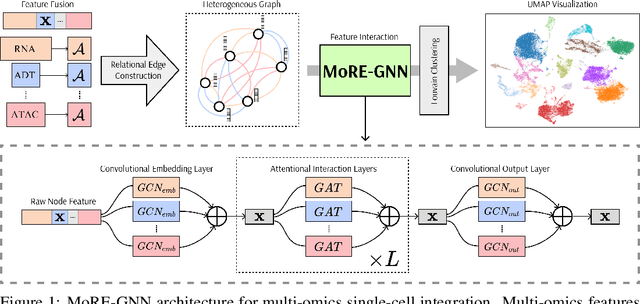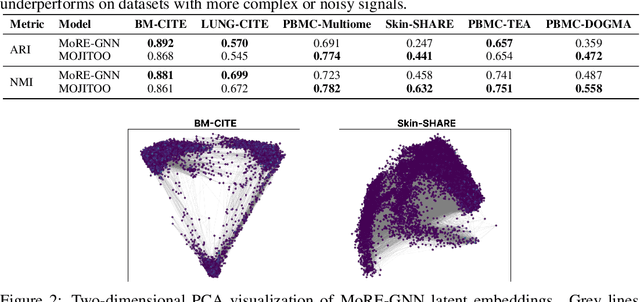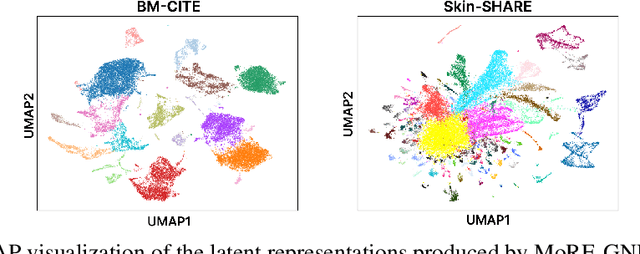Directed Graph Convolutional Network
Papers and Code
Bayesian Inference of Primordial Magnetic Field Parameters from CMB with Spherical Graph Neural Networks
Oct 23, 2025Deep learning has emerged as a transformative methodology in modern cosmology, providing powerful tools to extract meaningful physical information from complex astronomical datasets. This paper implements a novel Bayesian graph deep learning framework for estimating key cosmological parameters in a primordial magnetic field (PMF) cosmology directly from simulated Cosmic Microwave Background (CMB) maps. Our methodology utilizes DeepSphere, a spherical convolutional neural network architecture specifically designed to respect the spherical geometry of CMB data through HEALPix pixelization. To advance beyond deterministic point estimates and enable robust uncertainty quantification, we integrate Bayesian Neural Networks (BNNs) into the framework, capturing aleatoric and epistemic uncertainties that reflect the model confidence in its predictions. The proposed approach demonstrates exceptional performance, achieving $R^{2}$ scores exceeding 0.89 for the magnetic parameter estimation. We further obtain well-calibrated uncertainty estimates through post-hoc training techniques including Variance Scaling and GPNormal. This integrated DeepSphere-BNNs framework not only delivers accurate parameter estimation from CMB maps with PMF contributions but also provides reliable uncertainty quantification, providing the necessary tools for robust cosmological inference in the era of precision cosmology.
Learning noisy tissue dynamics across time scales
Oct 21, 2025Tissue dynamics play a crucial role in biological processes ranging from wound healing to morphogenesis. However, these noisy multicellular dynamics are notoriously hard to predict. Here, we introduce a biomimetic machine learning framework capable of inferring noisy multicellular dynamics directly from experimental movies. This generative model combines graph neural networks, normalizing flows and WaveNet algorithms to represent tissues as neural stochastic differential equations where cells are edges of an evolving graph. This machine learning architecture reflects the architecture of the underlying biological tissues, substantially reducing the amount of data needed to train it compared to convolutional or fully-connected neural networks. Taking epithelial tissue experiments as a case study, we show that our model not only captures stochastic cell motion but also predicts the evolution of cell states in their division cycle. Finally, we demonstrate that our method can accurately generate the experimental dynamics of developmental systems, such as the fly wing, and cell signaling processes mediated by stochastic ERK waves, paving the way for its use as a digital twin in bioengineering and clinical contexts.
Inferred global dense residue transition graphs from primary structure sequences enable protein interaction prediction via directed graph convolutional neural networks
Oct 15, 2025Introduction Accurate prediction of protein-protein interactions (PPIs) is crucial for understanding cellular functions and advancing drug development. Existing in-silico methods use direct sequence embeddings from Protein Language Models (PLMs). Others use Graph Neural Networks (GNNs) for 3D protein structures. This study explores less computationally intensive alternatives. We introduce a novel framework for downstream PPI prediction through link prediction. Methods We introduce a two-stage graph representation learning framework, ProtGram-DirectGCN. First, we developed ProtGram. This approach models a protein's primary structure as a hierarchy of globally inferred n-gram graphs. In these graphs, residue transition probabilities define edge weights. Each edge connects a pair of residues in a directed graph. The probabilities are aggregated from a large corpus of sequences. Second, we propose DirectGCN, a custom directed graph convolutional neural network. This model features a unique convolutional layer. It processes information through separate path-specific transformations: incoming, outgoing, and undirected. A shared transformation is also applied. These paths are combined via a learnable gating mechanism. We apply DirectGCN to ProtGram graphs to learn residue-level embeddings. These embeddings are pooled via attention to generate protein-level embeddings for prediction. Results We first established the efficacy of DirectGCN on standard node classification benchmarks. Its performance matches established methods on general datasets. The model excels at complex, directed graphs with dense, heterophilic structures. When applied to PPI prediction, the full ProtGram-DirectGCN framework delivers robust predictive power. This strong performance holds even with limited training data.
Learning Wireless Interference Patterns: Decoupled GNN for Throughput Prediction in Heterogeneous Multi-Hop p-CSMA Networks
Oct 15, 2025The p-persistent CSMA protocol is central to random-access MAC analysis, but predicting saturation throughput in heterogeneous multi-hop wireless networks remains a hard problem. Simplified models that assume a single, shared interference domain can underestimate throughput by 48--62\% in sparse topologies. Exact Markov-chain analyses are accurate but scale exponentially in computation time, making them impractical for large networks. These computational barriers motivate structural machine learning approaches like GNNs for scalable throughput prediction in general network topologies. Yet off-the-shelf GNNs struggle here: a standard GCN yields 63.94\% normalized mean absolute error (NMAE) on heterogeneous networks because symmetric normalization conflates a node's direct interference with higher-order, cascading effects that pertain to how interference propagates over the network graph. Building on these insights, we propose the Decoupled Graph Convolutional Network (D-GCN), a novel architecture that explicitly separates processing of a node's own transmission probability from neighbor interference effects. D-GCN replaces mean aggregation with learnable attention, yielding interpretable, per-neighbor contribution weights while capturing complex multihop interference patterns. D-GCN attains 3.3\% NMAE, outperforms strong baselines, remains tractable even when exact analytical methods become computationally infeasible, and enables gradient-based network optimization that achieves within 1\% of theoretical optima.
MoRE-GNN: Multi-omics Data Integration with a Heterogeneous Graph Autoencoder
Oct 08, 2025



The integration of multi-omics single-cell data remains challenging due to high-dimensionality and complex inter-modality relationships. To address this, we introduce MoRE-GNN (Multi-omics Relational Edge Graph Neural Network), a heterogeneous graph autoencoder that combines graph convolution and attention mechanisms to dynamically construct relational graphs directly from data. Evaluations on six publicly available datasets demonstrate that MoRE-GNN captures biologically meaningful relationships and outperforms existing methods, particularly in settings with strong inter-modality correlations. Furthermore, the learned representations allow for accurate downstream cross-modal predictions. While performance may vary with dataset complexity, MoRE-GNN offers an adaptive, scalable and interpretable framework for advancing multi-omics integration.
From Actions to Kinesics: Extracting Human Psychological States through Bodily Movements
Oct 06, 2025Understanding the dynamic relationship between humans and the built environment is a key challenge in disciplines ranging from environmental psychology to reinforcement learning (RL). A central obstacle in modeling these interactions is the inability to capture human psychological states in a way that is both generalizable and privacy preserving. Traditional methods rely on theoretical models or questionnaires, which are limited in scope, static, and labor intensive. We present a kinesics recognition framework that infers the communicative functions of human activity -- known as kinesics -- directly from 3D skeleton joint data. Combining a spatial-temporal graph convolutional network (ST-GCN) with a convolutional neural network (CNN), the framework leverages transfer learning to bypass the need for manually defined mappings between physical actions and psychological categories. The approach preserves user anonymity while uncovering latent structures in bodily movements that reflect cognitive and emotional states. Our results on the Dyadic User EngagemenT (DUET) dataset demonstrate that this method enables scalable, accurate, and human-centered modeling of behavior, offering a new pathway for enhancing RL-driven simulations of human-environment interaction.
Hierarchical Learning for Maze Navigation: Emergence of Mental Representations via Second-Order Learning
Sep 17, 2025Mental representation, characterized by structured internal models mirroring external environments, is fundamental to advanced cognition but remains challenging to investigate empirically. Existing theory hypothesizes that second-order learning -- learning mechanisms that adapt first-order learning (i.e., learning about the task/domain) -- promotes the emergence of such environment-cognition isomorphism. In this paper, we empirically validate this hypothesis by proposing a hierarchical architecture comprising a Graph Convolutional Network (GCN) as a first-order learner and an MLP controller as a second-order learner. The GCN directly maps node-level features to predictions of optimal navigation paths, while the MLP dynamically adapts the GCN's parameters when confronting structurally novel maze environments. We demonstrate that second-order learning is particularly effective when the cognitive system develops an internal mental map structurally isomorphic to the environment. Quantitative and qualitative results highlight significant performance improvements and robust generalization on unseen maze tasks, providing empirical support for the pivotal role of structured mental representations in maximizing the effectiveness of second-order learning.
Graph-based Point Cloud Surface Reconstruction using B-Splines
Sep 19, 2025Generating continuous surfaces from discrete point cloud data is a fundamental task in several 3D vision applications. Real-world point clouds are inherently noisy due to various technical and environmental factors. Existing data-driven surface reconstruction algorithms rely heavily on ground truth normals or compute approximate normals as an intermediate step. This dependency makes them extremely unreliable for noisy point cloud datasets, even if the availability of ground truth training data is ensured, which is not always the case. B-spline reconstruction techniques provide compact surface representations of point clouds and are especially known for their smoothening properties. However, the complexity of the surfaces approximated using B-splines is directly influenced by the number and location of the spline control points. Existing spline-based modeling methods predict the locations of a fixed number of control points for a given point cloud, which makes it very difficult to match the complexity of its underlying surface. In this work, we develop a Dictionary-Guided Graph Convolutional Network-based surface reconstruction strategy where we simultaneously predict both the location and the number of control points for noisy point cloud data to generate smooth surfaces without the use of any point normals. We compare our reconstruction method with several well-known as well as recent baselines by employing widely-used evaluation metrics, and demonstrate that our method outperforms all of them both qualitatively and quantitatively.
PhenoGnet: A Graph-Based Contrastive Learning Framework for Disease Similarity Prediction
Sep 17, 2025Understanding disease similarity is critical for advancing diagnostics, drug discovery, and personalized treatment strategies. We present PhenoGnet, a novel graph-based contrastive learning framework designed to predict disease similarity by integrating gene functional interaction networks with the Human Phenotype Ontology (HPO). PhenoGnet comprises two key components: an intra-view model that separately encodes gene and phenotype graphs using Graph Convolutional Networks (GCNs) and Graph Attention Networks (GATs), and a cross view model implemented as a shared weight multilayer perceptron (MLP) that aligns gene and phenotype embeddings through contrastive learning. The model is trained using known gene phenotype associations as positive pairs and randomly sampled unrelated pairs as negatives. Diseases are represented by the mean embeddings of their associated genes and/or phenotypes, and pairwise similarity is computed via cosine similarity. Evaluation on a curated benchmark of 1,100 similar and 866 dissimilar disease pairs demonstrates strong performance, with gene based embeddings achieving an AUCPR of 0.9012 and AUROC of 0.8764, outperforming existing state of the art methods. Notably, PhenoGnet captures latent biological relationships beyond direct overlap, offering a scalable and interpretable solution for disease similarity prediction. These results underscore its potential for enabling downstream applications in rare disease research and precision medicine.
Attention Maps in 3D Shape Classification for Dental Stage Estimation with Class Node Graph Attention Networks
Sep 09, 2025Deep learning offers a promising avenue for automating many recognition tasks in fields such as medicine and forensics. However, the black-box nature of these models hinders their adoption in high-stakes applications where trust and accountability are required. For 3D shape recognition tasks in particular, this paper introduces the Class Node Graph Attention Network (CGAT) architecture to address this need. Applied to 3D meshes of third molars derived from CBCT images, for Demirjian stage allocation, CGAT utilizes graph attention convolutions and an inherent attention mechanism, visualized via attention rollout, to explain its decision-making process. We evaluated the local mean curvature and distance to centroid node features, both individually and in combination, as well as model depth, finding that models incorporating directed edges to a global CLS node produced more intuitive attention maps, while also yielding desirable classification performance. We analyzed the attention-based explanations of the models, and their predictive performances to propose optimal settings for the CGAT. The combination of local mean curvature and distance to centroid as node features yielded a slight performance increase with 0.76 weighted F1 score, and more comprehensive attention visualizations. The CGAT architecture's ability to generate human-understandable attention maps can enhance trust and facilitate expert validation of model decisions. While demonstrated on dental data, CGAT is broadly applicable to graph-based classification and regression tasks, promoting wider adoption of transparent and competitive deep learning models in high-stakes environments.
 Add to Chrome
Add to Chrome Add to Firefox
Add to Firefox Add to Edge
Add to Edge